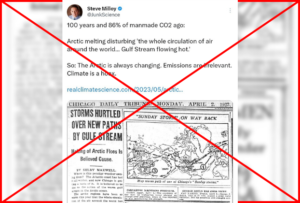Physical Address
23,24,25 & 26, 2nd Floor, Software Technology Park India, Opp: Garware Stadium,MIDC, Chikalthana, Aurangabad, Maharashtra – 431001 India
Physical Address
23,24,25 & 26, 2nd Floor, Software Technology Park India, Opp: Garware Stadium,MIDC, Chikalthana, Aurangabad, Maharashtra – 431001 India

By Vivek Saini
Claim: Arctic ice is always changing; it has nothing to do with the Emissions they are irrelevant.
Fact: Misinformation. Arctic ice sheet melting is one of the irreversible negative changes triggered by the changing climate due to global warming.
Claim post:

What does the post say?
A viral Twitter post by the climate science contrarian Steve Milloy dated 4 May, 2023 says that Arctic ice melting disturbed the whole circulation of the air around the world and concludes that the melting of the Arctic is a natural phenomenon that has been occurring since the turn of the century and is unrelated to emissions. The post also shared an article which has a newspaper clipping from April 2,1923, Chicago Tribune. The news mentions that the Arctic region has been very warm that year, resulting in disturbance in air circulation around the world. The post also mentions that “Climate is a hoax”.
What we found
The claim made by the post is Misleading and it has been found in different studies that Arctic heating rates are much faster than previously believed, making the region more sensitive to human induced global warming. Sea ice in the Arctic is melting quickly, raising the possibility of an ice-free summer in the near future. Arctic sea ice is now disappearing at a pace of 12.6% each decade, compared to its average extent from 1981 to 2010.
There have been other Misleading posts from this twitter account in the past which have been debunked by CFC India.
Why is Arctic ice important?
Most of us don’t reside in polar zones. Icebergs and ice sheets are not something we come into contact with very frequently. However, the climate we experience is influenced by the snow and ice in the Earth’s cryosphere, regardless of where we live.
Because the cryosphere – the ice portion of our planet – is so intertwined with other elements of the Earth system, whatever occurs there has an impact on the entire planet. Ice melts as a result of rising temperatures brought on by climate change.
The polar ice caps operate as a big umbrella, reflecting sunlight back into the atmosphere, a phenomenon known as the albedo effect. However, white ice and snow reflect significantly more of the sun’s light than the open water that is replacing them as the ice melts. Instead of being reflected away from the Earth, this energy is absorbed and contributes to global warming.
Since the middle of the 20th century, the average global temperature has risen by around 0.6°C (1.1°F), although not uniformly. In the Arctic, a phenomenon known as “Arctic amplification,” temperatures have risen approximately twice as quickly as they have in the mid-latitudes.
Some ice withstand the summer melt every year. When winter arrives, more water freezes, resulting in thicker and stronger “multiyear ice.” First-year ice is thinner and more prone to melting, fracturing, and even being washed away from the Arctic. With more ice melting each year, there is less long-term ice. As a result, Arctic sea ice is the youngest and thinnest it has ever been, making it a less effective blanket.
The Arctic sea ice’s seasonal variations are a key factor in controlling the climate worldwide. The largest Sea-Ice Extent (SIE) oscillations occur between the winter and summer months, and Arctic sea-ice covers a land-locked ocean region that goes all the way to the north pole. The Northern Hemisphere’s SIE exhibits negative tendencies throughout the year, with March recording the highest SIE and September recording the lowest. Since the 1970s, the SIE variability in late January has varied between 14 and 16 million km2, and in September, the extent is roughly 7 million km2.
Melting Arctic Ice: Indicator of Global warming
Sea ice is an essential component of the Arctic Ocean and a key indicator of climate change. During the dark months of winter, sea ice normally covers the bulk of the Arctic Ocean. The ice will melt in the summer because of warmer temperatures and prolonged exposure to the sun. The area covered by ice during the summer, when it will be at its thinnest by mid-September, is around half the size of the winter maximum. The ice begins to expand anew as the sun goes south and the winter months return.
The area covered by Arctic sea ice is an important indication of global climate change because the rate at which warmer air and higher water temperatures reduce the amount of existing sea ice can be assessed as world temperatures rise.
Because of its ability to reflect more sunlight back into space, sea ice plays a crucial role in maintaining the Earth’s energy balance and keeping polar regions cool. Sea ice also keeps the air cool by acting as an insulator between the chilly air above and the warmer water below.
As the melting sea ice changes to warmer saltwater, the Arctic region warms, potentially triggering a “feedback loop” in which the increased amount of warm seawater melts the sea ice quicker than before. The age of sea ice is a key indicator of Arctic conditions. As sea ice builds over time, it becomes stronger and thicker than younger ice. The disappearance of older sea ice indicates that the Arctic ice cover is thinning.
Impacts of the melting arctic sea ice
The continued rapid disappearance of Arctic sea ice has far-reaching implications for climate, environment, and human activity. These include increased Arctic warming, probable links between sea-ice loss and mid-latitude weather patterns, altered habitat for flora and animals, and shifting possibilities for human activity in the high north. While the Arctic and Antarctic hold the majority of this ice, changes brought on by the melting of this ice have an impact on the entire world as follows:
90% of the solar light that strikes snow and ice is reflected back into space. Each summer, more snow and ice melt due to global warming, exposing the land and ocean that were previously covered by the ice. The ocean and land absorb more solar energy because of their darker colors, and they then dissipate the heat into the atmosphere. The result is increased global warming. In this way, as the climate warms more, more ice melts. We call this feedback. In the coming decades, the Arctic Ocean may be completely devoid of sea ice throughout the summer, says a study that utilized computer models to forecast the future of the sea ice cover.
Polar soils that have been frozen for up to 40,000 years are thawing as a result of global warming. The soils’ stored carbon is released as carbon dioxide and methane into the atmosphere as they thaw. When these gasses are released into the atmosphere, they increase global warming, which further thaws frozen soil.
The Earth has been getting warmer, which has caused the sea level to rise by around 1-2 millimeters per year. Melting glaciers and ice sheets release water that was once held on land into the oceans, contributing to some of the sea level rise. Some ice sheets and glaciers are more susceptible than others. They are now less stable, moving more quickly towards the ocean, and putting more ice into the water due to global warming. The West Antarctic Ice Sheet and the Greenland Ice Sheet are two of these regions with less stable ice. Global sea level would increase by about 6.5 meters if the Greenland Ice Sheet disintegrated or migrated into the ocean and global sea level would rise by about 8 meters if the West Antarctic Ice Sheet melted or slid into the ocean.
References: